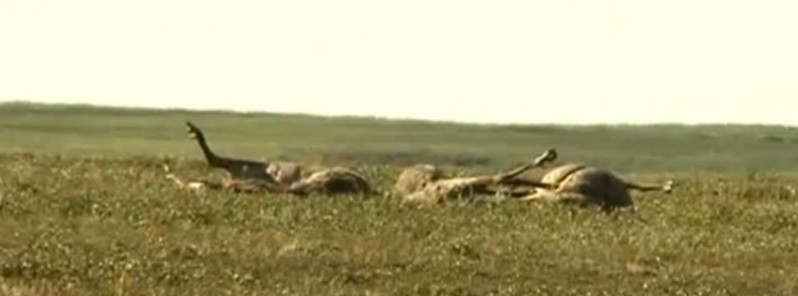Anthrax outbreak in Siberian Arctic, first since 1941

A dramatic rise in the number of hospitalized people diagnosed with anthrax was reported in Siberia's Yamal Peninsula, Russia on August 2, 2016. In total, 90 people, including 54 children, are in hospital as of August 2 in what is now the first anthrax outbreak in Siberia since 1941. The disease has already proved deadly for one person, a 12-year-old boy who died on July 30 after eating contaminated meat. More than 2 300 reindeer have died since the disease was first identified in late June 2016.
Russia's chief epidemiologist Lyudmila Volova said Tuesday, August 2 that "20 people out of 90 hospitalized have contracted anthrax. Two-thirds of them have the skin form of the disease, which is most straightforward to cure. The others have more complicated intestinal form."
So far, only one disease center has been discovered – the Yaroto lake in Yamalsky district.
There were 72 people hospitalized on August 1, a rise from 32 on July 29.
According to officials, a 12-year-old boy, member of a reindeer-herding family from the Yamal tundra, 2 100 km (1300 miles) N of Moscow, was the first fatality in Siberia linked to the pathogen since 1941.
Numbers of those now in the hospital exceed the total of 64 herders and their families who were at the apex of the infection, suggesting that the 'at risk' circle is now wider than the nomads at a camp at Yar-Sale in Yamalski district where the disease was first identified, The Siberian Times reports.
Governor Dmitry Kobylkin linked the outbreak to a massive temperature spike in the region.
Unusually hot temperatures were near 35 °C (95 °F) for more than a month in parts of the Siberian Arctic tundra which led to melting of the permafrost that contained a 75-year-old human or reindeer corpse contaminated with anthrax bacteria. Since this bacteria can survive for more than 100 years, and is highly resistant to temperature change, experts believe a reindeer came in contact with the contaminated meat and spread it to other animals. On August 1, the officials admitted that the cause of the anthrax outbreak could have been infected human remains from a local burial ground too.
Officials began investigating the outbreak in late June 2016. Since then, more than 2 300 reindeer have died. The exact causes of their deaths are unknown, but heatstroke and anthrax are the prime suspects. The remaining ~200 000 healthy animals are now being vaccinated.
The Siberian Times said that authorities now have to key concerns: "The first is fear for the survival of those now suffering from the intestinal form of the disease. The second is the deep concern that anthrax could spread to other areas of Russia."
As a response, a major operation involving Russia's bio-warfare troops is underway to incinerate at high temperatures the carcasses of the dead infected reindeer.
"A key danger is the spread of infected meat, which is the main carrier of the infection. The specific risk is black market meat from poachers. The regional government last night banned the export of any meat, antlers, or skins from the Yamalski district."
Meanwhile, Swedish authorities are investigating an anthrax outbreak at farms in central Sweden, The Local Sweden reported on August 2. " Eight cattle and a horse on separate farms near Omberg in the Östergötland region have died from splenic fever, as it is also called, after the first case of anthrax was confirmed by agricultural experts last month. They are located a couple of kilometers apart, and officials from Sweden's National Veterinary Institute are currently working on vaccinating livestock and tracing the source of the infection. Authorities are urging people to report dead deer or elk to the Swedish Board of Agriculture."
Anthrax is an infection caused by the bacterium Bacillus anthracis, spread by contact with the spores of the bacteria by breathing, eating, or through an area of broken skin. It can occur in four forms: skin, inhalation, intestinal, and injection.
Symptoms begin between one day and two months after contracting the infection. The skin form presents with a small blister with surrounding swelling that often turns into a painless ulcer with a black center. The inhalation form presents with fever, chest pain, and shortness of breath. The intestinal form presents with nausea, vomiting, diarrhea, or abdominal pain. The injection form presents with fever and an abscess at the site of drug injection.
Update
August 3, 2016
"Authorities expand buffer zone around anthrax spot in Russia's Yamal"
The buffer zone created around the hotbed of the anthrax outbreak in the Yamal-Nenets autonomous area has been expanded to 11 000 square kilometers, the press office of the region’s governor has told TASS.
"The buffer zone around the anthrax outbreak spot has been expanded to 100 kilometers by 110 kilometers (an area of 11 000 square kilometers) in order to prevent the further spread of the disease. Vaccination within the security zone will be mandatory. All reindeer will be examined and nomads’ health put under control, as follows from what the director of the veterinary department at Russia’s Agriculture Ministry, Vladimir Shevkoplias, told a news conference," the press-office said.
According to the authorities, the hotbed itself is much smaller. "Such a large buffer zone was created to be on the safe side. Massive death of livestock has been stopped."
Featured image credit: Vesti Yamal

Jos. Farrel says the disease story may be a cover for some other (big) thing …
Giza Death Star -WHAT’S UP WAY DOWN THERE? AND WHAT’S GOING DOWN WAY UP …
http://gizadeathstar.com/2016/07/whats-way-whats-going-way-russian-bio-hazard-team-sent-arctic/